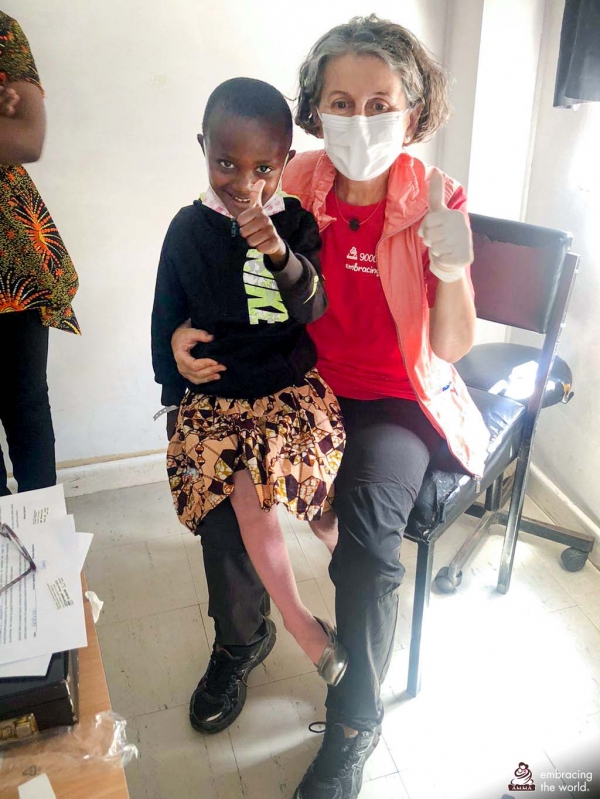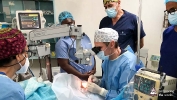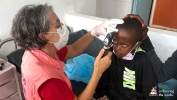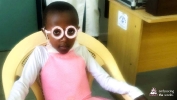Another milestone—for the first time, some of the surgeries could take place in an operating room instead of a mobile medical camp. A small hospital opened in one of Nairobi’s slums and welcomed the opthamologists, optometrists and nurses.
Most of the patients were from the Kikuyu ethnic group, which is the most common in the area, but people also travelled from remote areas such as Kissi, Meru and Mombasa. Some of the patients had been diagnosed with cataracts for a long time, but due to lack of resources, could not afford surgery.
Dr Isabel Signes Soler is an optometrist who is one of the project’s organizers. This year, she met a little girl who deeply inspired her out of the hundreds of patients she has met over the years, and so, she shares her experience.
Charity’s story: Just one eye please
Charity is six years old and came for eye surgery with her father. Her mother could not accompany her because Charity has a little sister whom her mother has to take care of. Charity was born with congenital cataracts, and when she came for the first appointment, she could barely see ten percent.During the consultation, she behaved very well. Despite her age, she allowed us to put drops in her eyes and do all the tests without complaining. She did not show resistance, nor did she cry at any time.
Charity’s surgery was scheduled on the last day of the campaign because we needed general anaesthesia, so had to perform it in another hospital with proper resources. On the day of, we went to Bhagati Hospital in Nairobi, set up the surgical microscope, and prepared the operating room to begin.
Charity came in relaxed, led by the hand of one of her caregivers. Soon the local nurses began to look for a vein in her right hand, and that was when she became nervous. What was happening? When prodding her, she began to cry inconsolably until she was anesthetized.
Once her vital signs had stabilized, the surgery began. Her right eye first. Only the beep-beep of the monitor that controlled her vital signs could be heard. The prayers were silent.
It was a slow surgery. After 30 minutes, the intraocular lens was implanted and everything went well. Next, Dr Jaime Javaloy continued with the other eye.
When finished, Charity was taken to the rehab room. Soon, she woke up and started crying. She had both eyes covered and couldn't see anything—all was dark. She was desperate because before surgery, although she saw very poorly, she saw light and could distinguish some contours.
She cried, “Ma, ma, ma…” Caregivers asked a relative to come, and her father entered the room, but the crying continued. I approached and began to speak to her with the intention to comfort her, but to no avail. We could barely hold her hands to keep her from removing her post-surgical blindfolds. In the end, we had to tie her hands to the bed.
Charity was yelling something in her local language, and I asked the nurse what she was saying. The nurse told me that Charity wanted us to uncover at least one eye, because if not, she would trip over everything when she got up.
After consulting with the surgeon, I approached the bed and said, “Charity, if you stop crying, I'll uncover one eye.”
Little by little she calmed down and I uncovered her right eye. Her eyelid was slightly swollen and she had to lift her head to try to see. She began to look left and right, shaking her head slowly. She calmed down some more. I told her that I would bring her a dress from Spain and asked her what colour she wanted. “Pink,” she replied.
Charity then asked for her mother to come, and soon she appeared with Charity’s little sister on her back. Charity’s father left the room and her mother put on a robe to gain access. From the door, Charity’s mother asked if she had already been operated on, and when she saw her daughter, her eyes filled with tears. The nurses noticed it, and looking at her, my eyes got wet, too.
Charity was still calm, so we removed the bandages that bound her to the bed. We gave care instructions to her mother and said goodbye until the next appointment.
The following day, I entered the room where Charity was and she already had both eyes uncovered. She was happy and her vision was much better. Her eyes were white and her corneas transparent, with no sign of the previous day’s surgery. Her spontaneous vision was 30% and she was prescribed drops for a month.
After two weeks, we visited for another checkup. Charity's vision improved even more and we were able to write a prescription for glasses. We will continue to track her progress until she is nine years old.
Charity lives with her mother in a rural area called Machacos, and her father works in Nairobi to earn a living for the family. She has not been to school for a full year because she could not see. She willp now be able to return to class and she will have a chance at life.
The strength of this little girl was surprising, despite her young age and her visual difficulties. After all, she turned out to be a good negotiator when she got us to remove that first bandage: “Just one eye, so I don´t fall.”
Photo 1: Charity’s dad holds her during a pre-op examination.
Photo 2: The team carries out Charity’s surgery.
Photo 3: Charity and her mom after the procedure.
Photo 4: Dr Isabel Signes Soler examines Charity’s eyes during a post-op checkup.
Photo 5: Thumbs up. Charity’s recovery is going well.
Photo 6: After two weeks, Charity’s vision had improved to a level where glasses could be prescribed.










